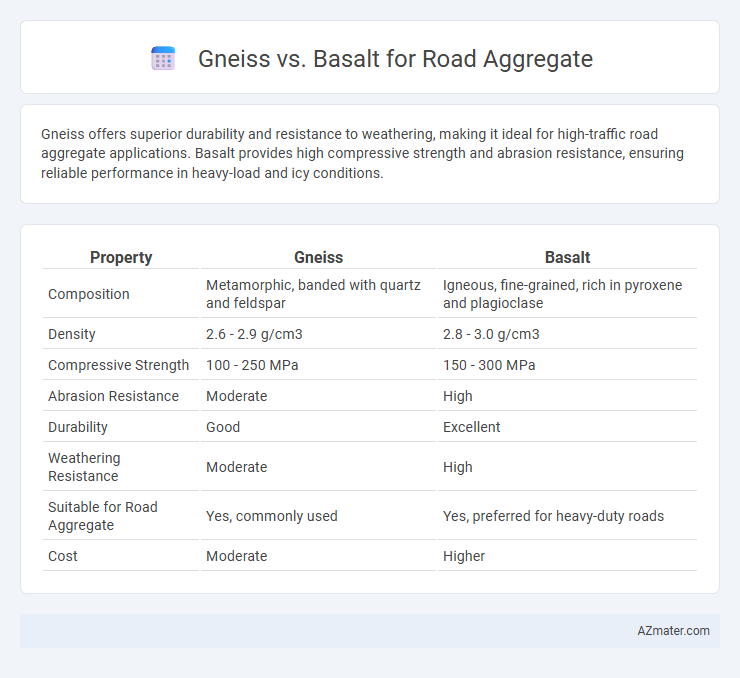Gneiss offers superior durability and resistance to weathering, making it ideal for high-traffic road aggregate applications. Basalt provides high compressive strength and abrasion resistance, ensuring reliable performance in heavy-load and icy conditions.
Table of Comparison
| Property | Gneiss | Basalt |
|---|---|---|
| Composition | Metamorphic, banded with quartz and feldspar | Igneous, fine-grained, rich in pyroxene and plagioclase |
| Density | 2.6 - 2.9 g/cm3 | 2.8 - 3.0 g/cm3 |
| Compressive Strength | 100 - 250 MPa | 150 - 300 MPa |
| Abrasion Resistance | Moderate | High |
| Durability | Good | Excellent |
| Weathering Resistance | Moderate | High |
| Suitable for Road Aggregate | Yes, commonly used | Yes, preferred for heavy-duty roads |
| Cost | Moderate | Higher |
Introduction to Gneiss and Basalt
Gneiss is a high-grade metamorphic rock characterized by its foliated texture and mineral banding, often composed of quartz, feldspar, and mica, making it durable and resistant to weathering. Basalt is a fine-grained igneous rock formed from rapid cooling of lava, composed mainly of plagioclase and pyroxene minerals, known for its high density and compressive strength. Both Gneiss and Basalt provide reliable strength and stability as road aggregates, but their mineral composition and formation processes influence their suitability for different road construction applications.
Geological Formation and Characteristics
Gneiss, formed through high-grade regional metamorphism of pre-existing rocks, exhibits a foliated texture with alternating light and dark mineral bands, providing high durability and resistance to weathering in road aggregate applications. Basalt, originating from rapid cooling of mafic lava flows, presents a fine-grained, dense, and non-foliated structure that enhances its strength and abrasion resistance, making it suitable for heavy traffic surfaces. The mineralogical composition of gneiss includes quartz, feldspar, and mica, while basalt predominantly comprises plagioclase and pyroxene, influencing their mechanical properties and suitability in pavement construction.
Physical Properties Comparison
Gneiss exhibits high strength and durability with low porosity, making it ideal for road aggregates that require resistance to weathering and heavy loads. Basalt offers superior abrasion resistance and high compressive strength, ensuring long-lasting pavement surfaces under intense traffic conditions. Both rocks have dense structures, but basalt's finer grain size provides slightly better stability and skid resistance for road applications.
Mineral Composition Differences
Gneiss, composed primarily of quartz, feldspar, and biotite, offers a high degree of hardness and durability suitable for road aggregate. Basalt, an igneous rock rich in plagioclase and pyroxene minerals, provides excellent mechanical strength and resistance to abrasion. The mineral composition differences result in varied performance characteristics, with gneiss offering greater resistance to weathering due to its metamorphic origin, while basalt delivers superior compressive strength.
Mechanical Strength and Durability
Gneiss exhibits high mechanical strength due to its coarse-grained, foliated structure, making it highly resistant to crushing and abrasion in road aggregate applications. Basalt offers superior durability with excellent resistance to weathering and chemical breakdown, contributing to extended road lifespan. Both materials provide robust performance, with gneiss favored for strength in heavy traffic conditions and basalt chosen for long-term durability under varied environmental stresses.
Aggregate Shape and Surface Texture
Gneiss aggregates typically exhibit an angular to sub-angular shape with a rough, irregular surface texture that enhances interlock and stability in road construction. Basalt aggregates are generally more angular with a fine-grained, dense surface texture, providing excellent strength and resistance to abrasion. The rough surface of gneiss improves bonding with asphalt or concrete binders, while basalt's uniform texture contributes to durability and load-bearing capacity.
Performance in Road Construction
Gneiss exhibits high durability and excellent load-bearing capacity, making it ideal for road aggregate applications that require strong structural support and resistance to weathering. Basalt, known for its dense and hard composition, provides superior skid resistance and abrasion resistance, enhancing road surface safety and longevity. Both materials contribute significantly to pavement stability, but gneiss excels in flexural strength while basalt offers enhanced surface friction under heavy traffic conditions.
Environmental Impact and Sustainability
Gneiss, a metamorphic rock, offers superior durability and resistance to weathering, reducing maintenance frequency and associated environmental disruption when used as road aggregate. Basalt, an igneous rock, though strong and abrasion-resistant, requires more energy-intensive quarrying and processing, leading to higher carbon emissions compared to gneiss. Utilizing locally sourced gneiss minimizes transportation emissions, enhancing sustainability by lowering the overall carbon footprint of road construction projects.
Cost and Availability Analysis
Gneiss and basalt differ significantly in cost and availability for road aggregate applications, with basalt generally being more cost-effective due to its widespread occurrence and easier extraction processes. Gneiss, often found in limited geological formations, tends to be pricier because of its harder mining and processing requirements. Availability of basalt is higher in volcanic regions, making it a preferred choice for large-scale infrastructure projects requiring consistent supply and lower transportation expenses.
Conclusion: Best Choice for Road Aggregate
Gneiss, known for its high durability and excellent load-bearing capacity, offers superior resistance to weathering and abrasion, making it an ideal choice for road aggregate. Basalt provides strong mechanical properties and good skid resistance but may be more prone to weathering in certain climates compared to gneiss. Overall, gneiss is typically the best choice for road aggregate due to its enhanced longevity and performance under heavy traffic conditions.

Infographic: Gneiss vs Basalt for Road Aggregate
 azmater.com
azmater.com